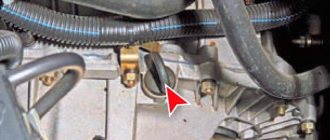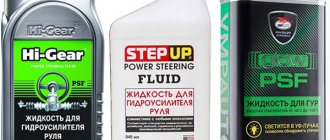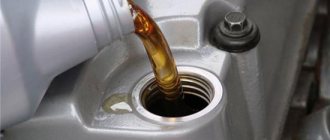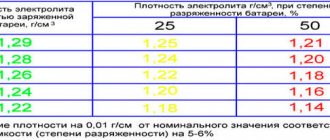I am an engineer by profession, but I have been interested in motor vehicles for many years now and have an almost top-level understanding of all areas of the automotive topic. Today I decided to look into the issue of oil, since many drivers ask and want to know whether it is possible to mix different (in this case we are talking about 5W30 and 5W40 lubricants) types of oils for car operation and how much this will affect the engine.
I have extensive experience working with engines and have used many oils in my practice, so I tried to thoroughly understand this issue. I hope the text below can help both novice car enthusiasts and provide answers to some of their questions even for experienced Kuzmichas, and will also help to avoid mistakes during car repairs.
In addition, you will be able to learn a lot from other people's experiences and gain effective advice for yourself.
Mixing different oils
When carrying out mechanical maintenance of a car, many even experienced car owners asked: is it possible to mix motor lubricants with different markings?
Even the opinions of abstruse experts differ on this issue, some of them say that mixing mixtures is dangerous for the health of the engine and generally reduces its service life, while others are completely sure that it is impossible to establish 100 percent the fault of the mixed oil in the operation of the car and in general mixing cannot lead to any consequences.
We will try to understand on our own whether it is possible to mix 5W30 and 5W40 automobile oils, and we will also find out what this can lead to.
- The need to pour new oil into old oil (meaning oils of different types) or to mix oils of different types appears when there is a certain amount of unused lubricant. Nobody wants to throw away old lubricant, which is why car enthusiasts save the oil for filling another time and try to save money in this way.
- There are also situations when engine lubricant is urgently needed and the driver does not have the required amount of the composition here and now. What to do in this case?
Classification of motor oils by season
- Summer oil has a higher viscosity index, which allows the product to function normally in the engine at positive temperatures. At the same time, the most viscous oil creates a thick protective film on parts, providing high-quality surface protection from damage and wear.
- Winter oil has a reduced viscosity; it can easily start the engine in winter frosts. But the most liquid oil, after heating the engine, creates a thin oil film, which protects the engine surfaces much less well, unlike summer oils.
- All-season engine oil , compared to summer and winter, does not require seasonal replacement; there is no need to replace it at the end of winter or summer; you can drive it all year round. Considering that today all modern oils have become all-season, they combine the optimal balance, including the necessary parameters for summer driving, as well as for winter trips.
To classify oils according to the dependence of the viscosity parameter on temperature, there is a special classification developed in institutes. It is called SAE, and determines that summer oils have a viscosity in the range of 20-60, and winter oils from 0W to 25W.
The integration of these two parameters is separately indicated on multi-grade oil and is known to drivers. Let's look at the viscosity of the widely used 5w40 and 5w30 oils, and what the markings of these oil brands mean. The choice of oils in question for a diesel engine provides the same results as for a gasoline engine.
How do 5W30/5W40 oils differ from each other?
At first glance, it may seem to you that the differences are only in the designation on the bottle and labeling; it seems as if one number does not solve anything, especially if you drive a car in the summer. In fact, what difference does it make what oil you use in hot weather if the numbers indicate the level of non-freezing of the mixture?
But the numbers still do not guarantee stable operation with mixed lubricant, because there are also individual differences that can also significantly affect the stability of the motor.
- According to the CAE standard adopted in Europe and the USA, this designation 5W30/5W40 shows the differences between positive temperatures, under which the oil retains properties suitable for operation. For a 5W30 type mixture, the highest operating temperature in the engine should not be more than 30 degrees, and for 5W40 oil, this temperature should not exceed 35 degrees.
- This parameter of the thermal stability of the lubricant can be explained as follows - engine oils have different viscosity values. Oil type 5W30 has a much more unstable and fluid structure, which guarantees the best distribution of the product under various conditions.
- The 5W40 series oil is more characterized by a consistency that is stable in viscosity, which is required for better preservation of oil characteristics with a large increase in temperature or humidity. Also, this oil does not provoke the appearance of crystallization of the product at low temperatures.
- The properties of the oil are also affected by the manufacturer and its composition. A huge number of oil refining companies in the world produce oils for cars, so it would be quite absurd to think that these lubricants are complete copies of each other. Even if you take one company, the 5W30 and 5W40 lubricants created by it are very different in their structure.
The differences also include the chemical base of the oils and tolerances. These lubricants can be sold in the form of various chemical substances (in the form of mineral water, semi-synthetic or have a synthetic base), so the tolerances are also the same.
Having learned all this, I personally immediately stopped wanting to mix these types of liquids in one engine - since they differ quite significantly in almost all parameters. Accordingly, I do not recommend doing this unless you want to ruin your motor or significantly reduce its service life.
conclusions
There are many videos on the Internet where the authors claim that you can mix anything, in any proportions and viscosities - be it 5W30, 5W40 or 5W60, mineral water or synthetics. This is actually not true. You can mix oil liquids only in the most extreme cases, when there is no other choice. For example, during a trip a leak appears and the engine gradually loses lubricant. The goal is to use any other oil composition so that you can drive a couple of hundred kilometers to the service station. There, find the cause of the leak, flush the engine and fill in the required oil. Such a mileage will not interfere with the engine, it will not have time to be damaged.
You can mix synthetics with synthetics, mineral water with mineral water, or add synthetics or mineral water to semi-synthetics, since they already have both bases. All this is acceptable if you mix lubricants from the same manufacturer - even if they belong to different model series, but have similar characteristics and the same basic composition.
Interaction between oils of the 5W30 and 5W40 series
Keep in mind that in one vehicle power plant it is possible to mix only those motor lubricants that have a certain similarity. For example, oils were produced by one manufacturer and have the same chemical. base. In this case, the oil creates a homogeneous structure that can act freely in the power unit without any particular consequences for the operation of the machine. But the problem is that, as mentioned earlier, manufacturers create completely different oils and mixing one with the other is strictly not recommended.
Tuning UAZ Patriot
This is not to say that the UAZ Patriot does not need tuning. Already at first glance, the obvious discrepancy between the size of the wheels and the huge body of the car is striking. As a rule, after lifting the body above the frame, the wheels are replaced with larger, 33-inch ones. This not only improves the appearance of the car, but also significantly increases its maneuverability.
The plastic bumper does not inspire any confidence. Looking at it, it becomes clear that it will disappear at the first forest hummock. Therefore, the bumper is replaced with a stronger steel structure, which in turn is reinforced with a guardrail. The next point is tuning the factory thresholds, replacing them with a stronger and more reliable option.
Comparison of synthetic base and mineral
In this matter, I can only advise one thing - try it and try to learn from your own experience, but I wouldn’t count on a good result if I were you. By itself, mineral water from any manufacturer does not have good viscosity and loses it under long-term loads or with large temperature jumps down or up. Therefore, various additives are usually added to the mixture to improve the physical properties of the oil.
This is how unstable motor oil is formed in the car, which evaporates under the influence of maximum temperature. European chemists advise drivers to mix synthetic and regular oil only when absolutely necessary. But it’s still better not to do this.
When we combine oils of the 5W30 and 5W40 series, we get a mixture labeled 5W3X, in which the X value is essentially an indicator that depends on the volume of the first/second oil. This composition can only be used in a car for a few days: then the oil will quickly lose its performance properties and become like some kind of mass with an incomprehensible color.
Automotive companies try to accurately establish and give instructions which mixtures should be used for filling the engine, and which ones are not recommended to be used.
If a day ago you filled your car with 5W40 series lubricant, and now you decide to add 5W30 series oil there, then the previous viscosity indicator will be forever lost and the weak viscosity of the lubricant will not be able to retain the lubricant on metal surfaces.
Let's compare
As you know, any modern lubricant includes a base (it can be the basis for many) and additives (which give the selected product an original character). Additives determine the appropriate effect for winter or summer time. Increasingly today, to facilitate choice and for the convenience of car owners, universal lubricants that are all-season are used. The oils we compare - 5w30 and 5w40 - contain different numbers of thickening additives.
{banner_content}That is why the second number given in the markings is different, but all the other numbers and letters are not. This is an indicator of the viscosity of a lubricant at elevated temperatures. 30 or – 40 means how long the product can form a certain protective film in the heat.
The degree of protection of the engine from premature wear or its sudden stop (when standing in a traffic jam for a long time in the heat, for example) depends on this.
What can mixing these lubricants lead to?
If you are a fan of experimenting with your car and you don’t care how the power plant works, then experts warn about the consequences of mixing oils.
As we have learned, motor lubricants with almost identical compositions and tolerances can be mixed with each other and driven on this mixture for several days, without impairing the usual performance of the engine compartment.
In addition to oil starvation, there is a huge likelihood of aggressive chemicals appearing. reactions due to incompatible additives. Their production technology is usually kept secret by manufacturing companies.
When should you mix 5W30 and 5W40 series oils?
When studying the instructions for your car regarding the engine (you can find it in the car manual), you should pay attention to those types of oils that are prohibited for use. If among these oils there is at least one of the lubricants discussed above, then there can be no talk of any miscibility.
Such seemingly safe actions with your car at first glance can provoke quite tangible consequences, but still, the likelihood of their occurrence is at a low level. Therefore, it is recommended to add oils of different series to each other only as a last resort.
For example, if you are going on a trip and suddenly realize that the lubricant level is at a low level, while the store is still quite far away, then you can fill in almost any mixture that comes to hand. The main thing here is that you don’t forget to drain this mess in the near future.











